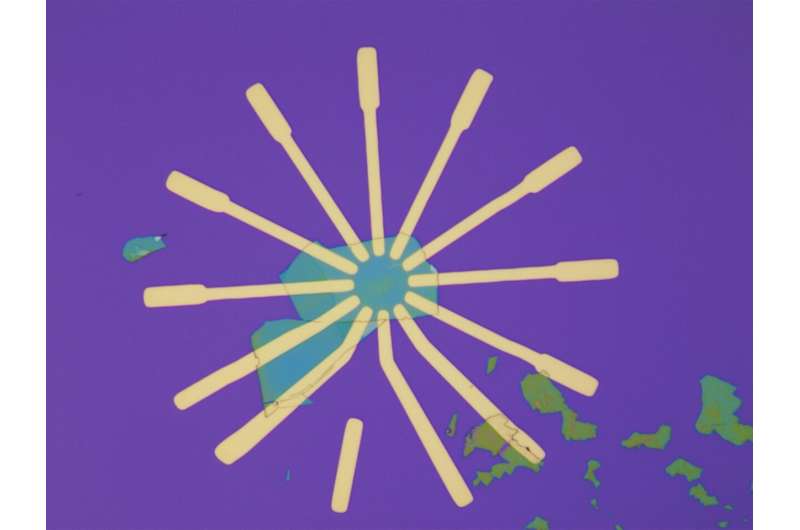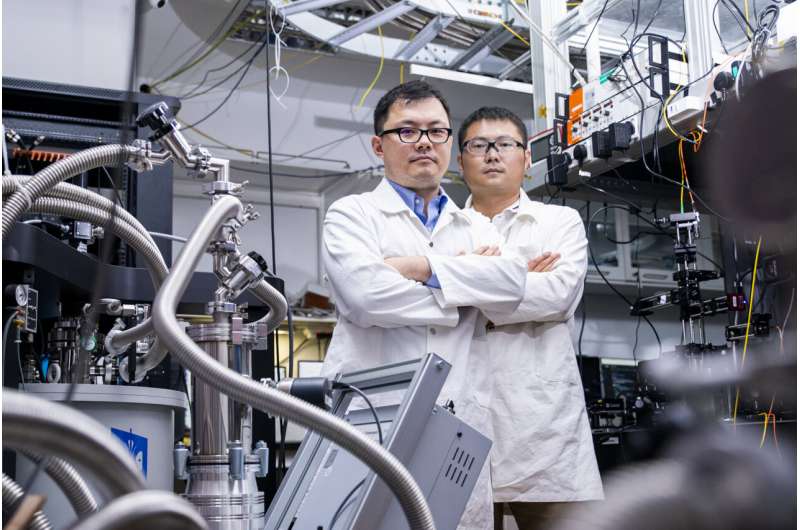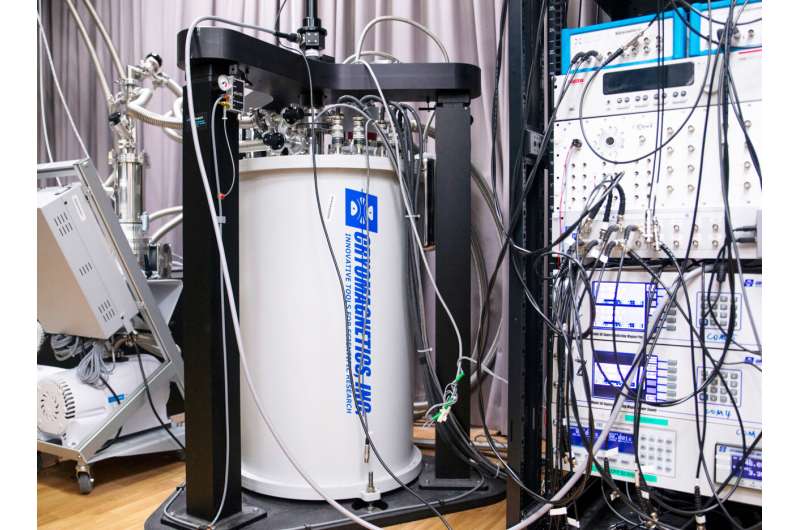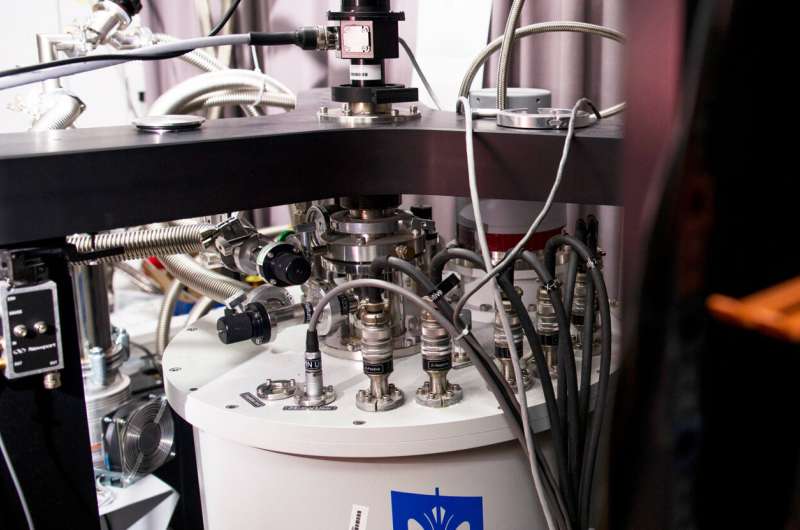This article has been reviewed according to Science X's editorial process and policies. Editors have highlighted the following attributes while ensuring the content's credibility:
fact-checked
peer-reviewed publication
trusted source
proofread
New way to read data in antiferromagnets unlocks their use as computer memory

Scientists led by Nanyang Technological University, Singapore (NTU Singapore) investigators have made a significant advance in developing alternative materials for the high-speed memory chips that let computers access information quickly and that bypass the limitations of existing materials.
They have discovered a way that allows them to make sense of previously hard-to-read data stored in these alternative materials, known as antiferromagnets.
Researchers consider antiferromagnets to be attractive materials for making computer memory chips because they are potentially more energy efficient than traditional ones made of silicon. Memory chips made of antiferromagnets are not subject to the size and speed constraints nor corruption issues that are inherent to chips made with certain magnetic materials.
Computer data is stored as code comprising a string of 1s and 0s. Currently, methods exist to "write" data onto antiferromagnets, by configuring them so that they can represent either the number 1 or 0.
However, "reading" this data from antiferromagnets has proved elusive to researchers as there were no practical methods in the past that could figure out which number the materials were coded as.

Now scientists led by Associate Professor Gao Weibo from NTU's School of Physical and Mathematical Sciences (SPMS) have found a solution.
Results from their experiments, published online in Nature in June 2023, showed that at ultra-low temperatures close to the coldness of outer space, if they passed a current through antiferromagnets, a unique voltage was measured across them.
Depending on whether this voltage was positive or negative, the scientists could figure out if the antiferromagnets were coded as 1 or 0. This then allows the data stored in the materials to be read.
"Our discovery provides a straightforward way to read data stored in antiferromagnets by being able to distinguish the two states the materials can take," said Assoc Prof Gao. "The findings advance research in using antiferromagnets for computer memory in the future."
Chips for computer memory, also called random-access memory (RAM), are used to quickly access data, such as for opening software and editing documents in computers.
Memory chips made with antiferromagnets are expected to store and change data more quickly than those made from magnetic materials called ferromagnets because they can change between the 1 and 0 states about 100 times faster. This is useful for resource-intensive computing tasks.
Researchers from Israel's Weizmann Institute of Science, Japan's National Institute for Materials Science and China's Chongqing University also contributed to the NTU-led study.
The research findings exemplify a key focus of the NTU 2025 strategic plan on interdisciplinary research with significant intellectual and societal impact.
Magnetic problems
Computer memory traditionally comprises silicon microchips. But in the past few decades, researchers have been looking at using magnetic materials called ferromagnets, made from alloys of cobalt and iron, for memory chips, and that are now used in artificial intelligence and space applications. This is partly because ferromagnetic chips are more energy efficient than silicon ones.
Memory chips make use of the internal properties of ferromagnets to store data. Ferromagnets have "mini magnets" in them owing to how their electrons behave. When these mini magnets are aligned in a specific way, the materials will be in a state that can represent 1. Orienting the mini magnets in a different way results in a state representing 0.

However, if ferromagnetic chips are exposed to magnetic fields, such as those from power lines or industrial equipment with electromagnets, these intrinsic properties—the alignment of the mini magnets—can get disrupted, thus corrupting or destroying the data that is stored.
While this problem can be solved by shielding the chips, ferromagnets also produce magnetic fields themselves that can disrupt the internal properties of other nearby ferromagnets.
Antiferromagnets can overcome these issues as they do not produce magnetic fields because their internal properties are slightly different from those of ferromagnets, due to how their mini magnets are aligned.
This also means that they will not become disturbed in the presence of other magnets, and more antiferromagnets can be packed in the same amount of space than ferromagnets, thus increasing memory capacity.
Still, despite finding ways to configure the antiferromagnets to encode data as 1s and 0s, reading this information has been difficult since there were no practical methods that could distinguish what state the materials were in.
Unique voltage solves data-reading problem
While studying the physical properties of a new antiferromagnetic material called manganese bismuth telluride, Assoc Prof Gao's team stumbled on an observation that solved the data-reading problem.
In their experiments, the scientists passed an alternating current through a very tiny device the size of a raindrop consisting of manganese bismuth telluride crystal flakes at extremely low temperatures of around 5° Kelvin or -268° Celsius, which approaches the coldness of outer space.

Surprisingly, the researchers found a unique voltage signal across the crystals with a frequency double that of the alternating current. For instance, passing a current of 10 microamperes at a frequency of 100 hertz produced a voltage of 0.2 millivolts with a frequency of 200 hertz. The scientists had expected the frequencies of the voltage and current to be the same.
They also found that depending on how the antiferromagnetic manganese bismuth telluride was configured, the sign of the voltage would change.
If the voltage was positive, it meant the antiferromagnet was in a state representing 0. If the voltage was negative, the material was in a state representing 1. This observation solves the problem of not being able to easily read information stored in antiferromagnets.
The scientists believe that other antiferromagnets will display a similar behavior and their next step will be to test such materials that can encode data at room temperature.
The researchers said that the unique voltage arises from the electronic properties of the manganese bismuth telluride crystals, called the quantum metric. The properties have not been experimentally observed until recently. This latest finding points the way towards further investigations into systems where such properties matter and which are explained by quantum mechanics, the study of how matter and energy behave at the atomic and subatomic level.
One of the independent and anonymous reviewers of the paper wrote that the group's experiments "discover the transport phenomenon caused by the quantum metric, which is significant for topology physics," adding that the "experimental results are solid and convincing."
The NTU-led scientists also found that besides the unexpected voltage they detected, there was another voltage that arose from a direct current induced by the alternating current passing through the manganese bismuth telluride crystals. For example, they found that a 10 microamperes alternating current would produce a voltage of 0.3 millivolts that was linked to the direct current.
The discovery suggests that wireless energy, like that from Wi-Fi and mobile signals, could cause antiferromagnets to produce electricity that might one day be tapped to power portable electronic devices.
Assoc Prof Gao said that his team is planning further research to increase the amount of energy that could be harvested in this way.
More information: Naizhou Wang et al, Quantum metric-induced nonlinear transport in a topological antiferromagnet, Nature (2023). DOI: 10.1038/s41586-023-06363-3
Journal information: Nature
Provided by Nanyang Technological University




















